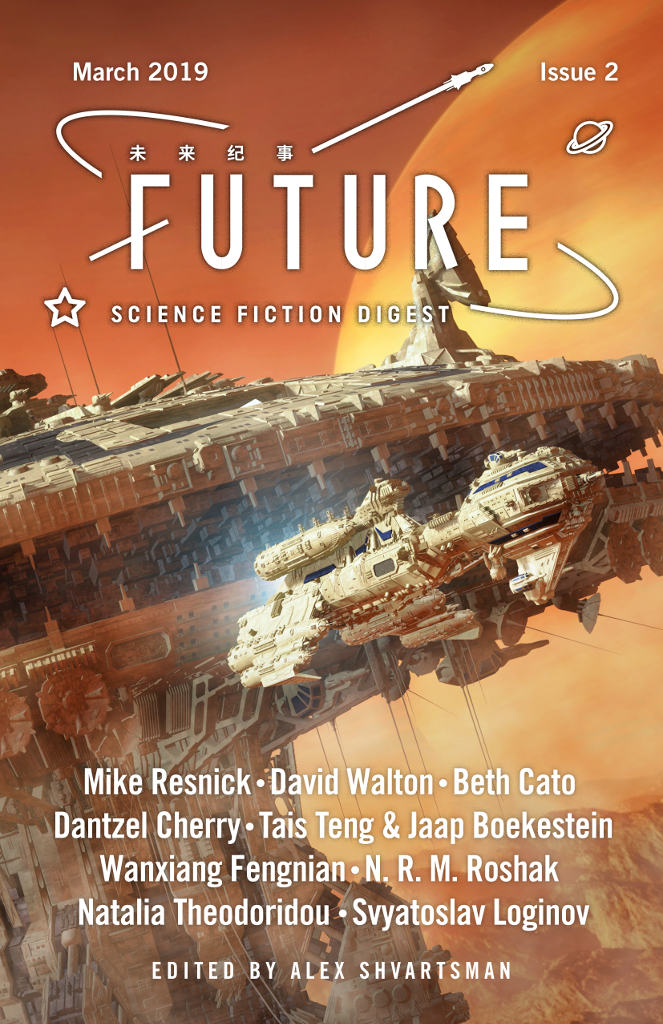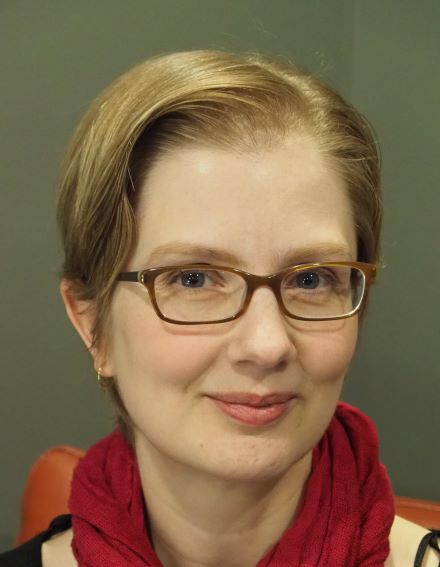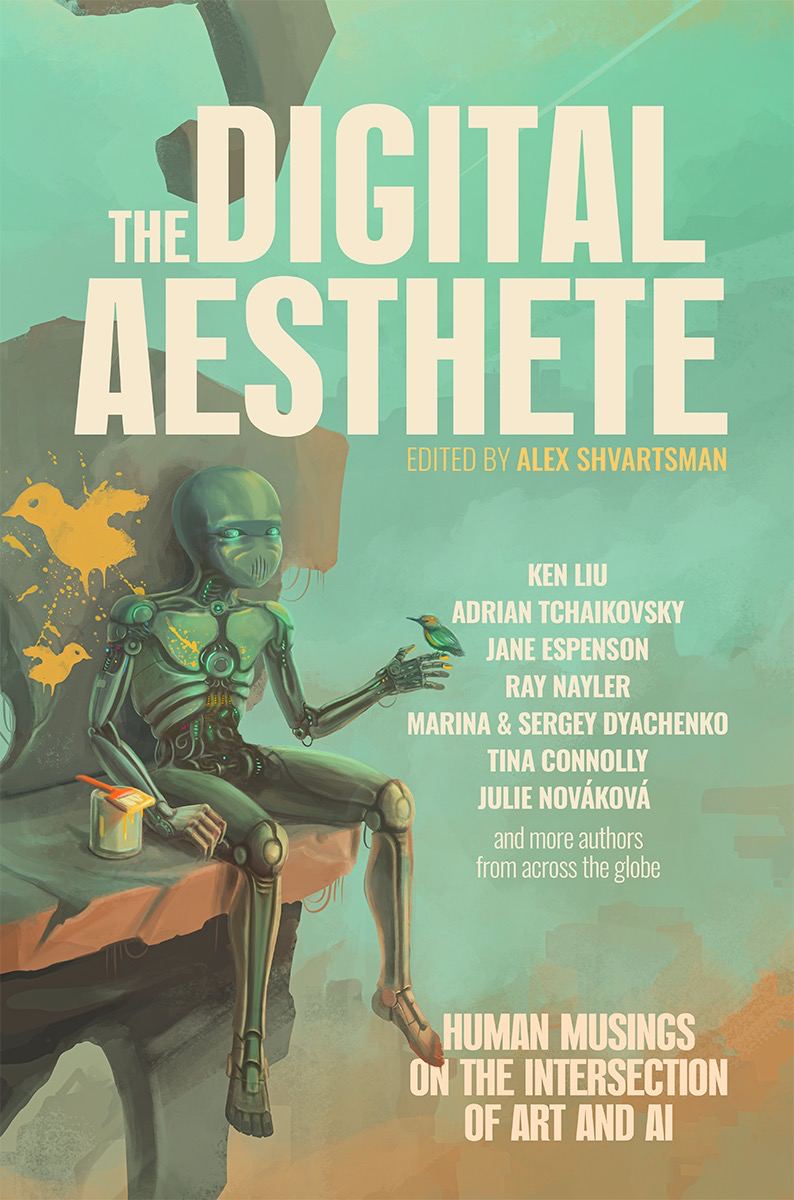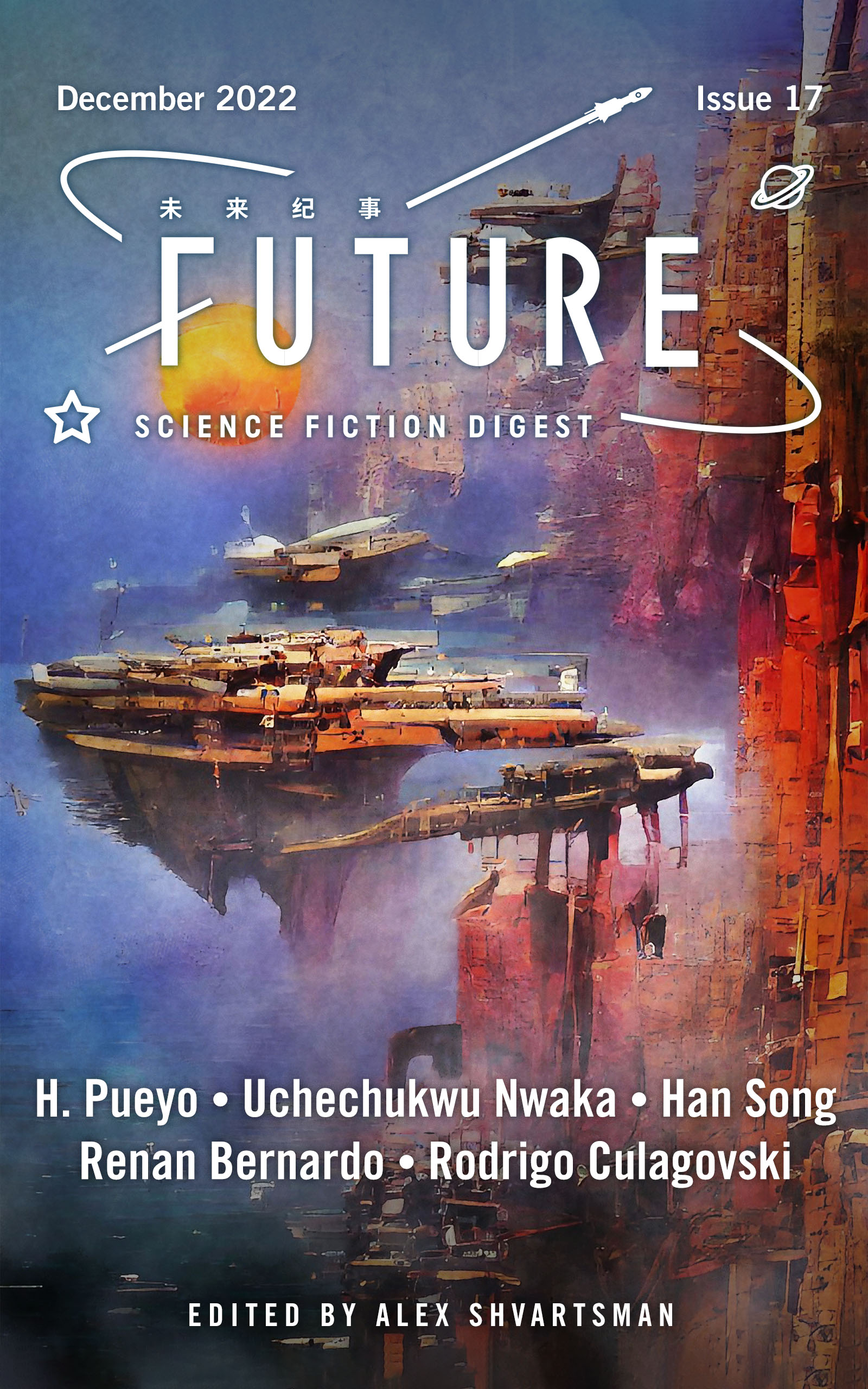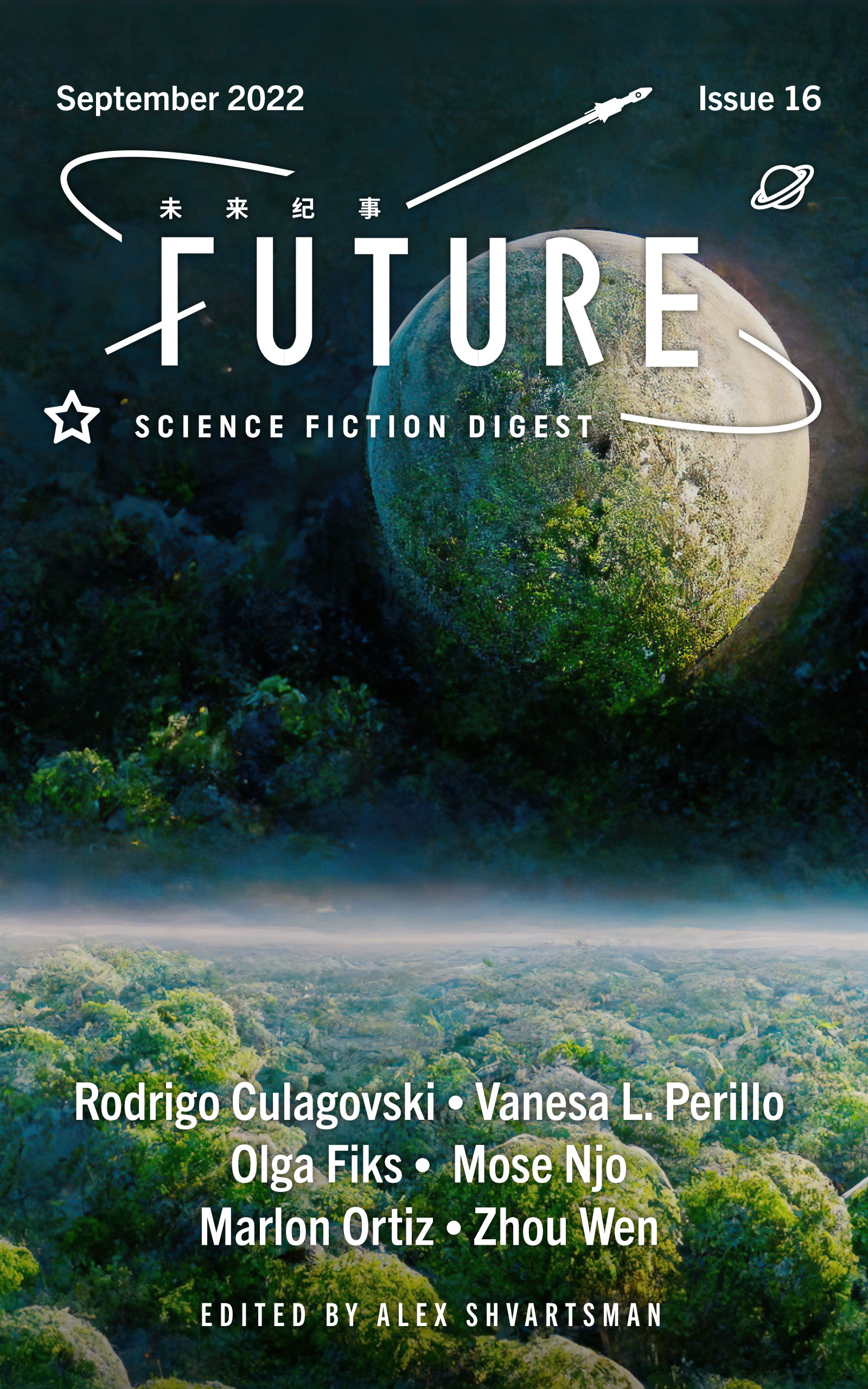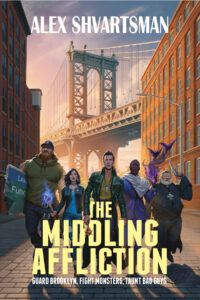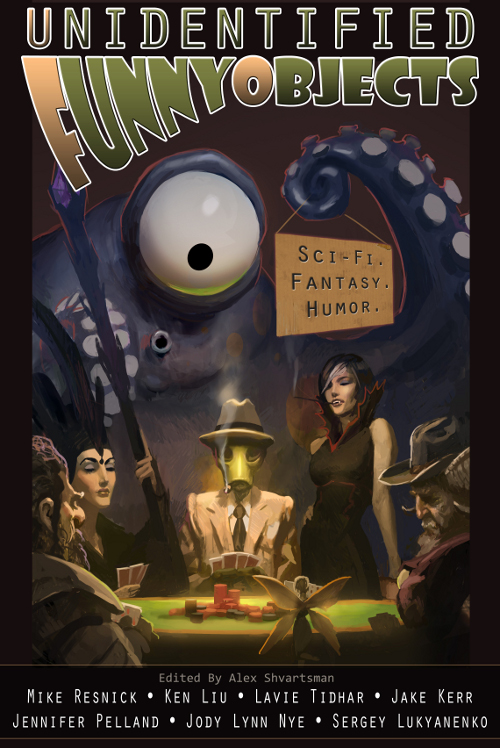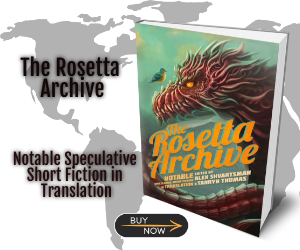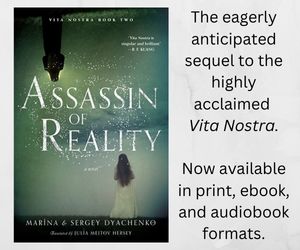Humanity had been hoping for some transformative, revolutionary technology, but what the aliens left us was a salad dressing recipe.
It used some weird feedstocks, but what came out of the fab looked, smelled, and tasted a lot like Kraft Zesty Italian. Zesty Alien, as it was immediately dubbed, made a pretty good chicken marinade, but on salad it was just kind of so-so.
Still, raw salads, which had become passé since the whole closed-loop humanure agriculture thing took off, enjoyed a brief renaissance among the true believers. They were the same benighted worshippers who had made pilgrimages to the alien ships when they had floated offshore, and had foundered against their silent, impenetrable hulls and required rescue by the Coast Guard. Now their Church of the Beyond preached that Zesty Alien was a panacea that would prevent any ill effects, and that its form as salad dressing indicated they should take up the holy communion of the raw salad. Unfortunately for them, that theory crumbled under a rash of E. coli outbreaks and one regrettable episode of cholera.
As it happens, it was my own, cooked, green bean salad that changed the world.
I had never been terribly focused on the aliens, who had floated around in various oceans for a few months, avoiding armies, navies and air forces with embarrassing ease, before vanishing, leaving their recipe engraved in seven-foot-high letters on several of the world’s most-visited mountains. The whole episode had seemed surreal to me, and frankly, irrelevant to my culinary studies. But my new girlfriend was a fabricator tech, and the alien salad dressing recipe was the hottest fab recipe on the planet. I’d wanted to serve her something I could dress with Zesty Alien, to impress her. So I whipped up a salade de haricots vinaigrette, a.k.a. green bean salad—a ridiculously simple recipe for the budding chef I was then.
The cooked, chilled, and Zesty-Alien-dressed vegetables had been marinating in the hot sun for a full day before my new girlfriend, whose name was Susan, dug in with a plastic fork. The fork was disposable, non-recyclable polystyrene, the kind that we weren’t supposed to use anymore because they landed in the oceans and stabbed fish and choked sea turtles and never ever went away, but that we all still brought to picnics regardless. Susan took a fork, without sparing a single thought for the fish and the sea turtles, and took a bite of my green bean salad.
I’d been hoping to impress her with my fab savvy. But what she immediately noticed, I soon found out, was that the fork tasted better than the veggies.
That’s not to say that the vegetables tasted bad. Cooked veggies taste just as good with Zesty Alien as they do with Zesty Italian: not amazing, but okay. But the fork, now. The fork tasted great. My girlfriend couldn’t help herself. She took a bite of the fork. And it was, honestly, terrific. Better than candy. Better than steak.
Of course, Susan tried to hide her fork-nibbling from me, but I hadn’t had nearly enough wine to miss the fact that she was pretending to eat her salad with an ever-shrinking fork handle. I was, however, just drunk enough to try it for myself. The taste, even for a chef, is hard to describe. I mostly tasted the pedestrian garlic-herb tang of Kraft Zesty Italian; but as the dressing-soaked fork crunched between my teeth, it was somehow more luscious and satisfying than Wagyu beef.
Soon the picnic food was abandoned in favor of the picnic plastic. We ate the cutlery, and the cups, and even the plastic container that the green bean salad had been soaking in. By nightfall the food was scattered across the soft grass and the last shred of packaging was gone.
We didn’t even have stomachaches when we woke up the next day. What we did have was a bit of a craving. Plastic, it seemed, was not only delicious when dressed with Zesty Alien. It was a craving-inducing delight. I’m not talking heroin craving, or even cigarette craving. At that point, it was more of a chocolate-level craving. So, Susan fabbed up a pint of Zesty Alien and we dug in. I made us salads of shredded trash bags with crunchy plastic croutons, carved us steaks out of a Styrofoam takeout container, served us an ersatz oeufs à la neige of plastic bottle caps floating in a puddle of Zesty Alien. And Susan livestreamed it all. She’d never been a food vlogger before. Her prior streams had focused on her technical specialty, vintage fabricator recalibration. But she’d discovered a new taste, and she was having far too much fun not to share. And I was delighted to have my own videographer.
Our channel took off. Suddenly plastic-eaters were everywhere. Disposable plastic bags flew off the shelves. Stores couldn’t keep plastic cutlery in stock. Parties ran out of beer cups long before they ran out of beer. Beef steaks and pork roasts languished in supermarkets while customers bought chicken feet, pig trotters and gizzards, dumping the offal and eating the plastic tray. Paper bag sales were up, since no one could bear to stuff plastic garbage bags full of trash. Trash, on the other hand, was down: we were eating much of what we’d once thrown out.
Household waste had diminished by 42 percent by the time scientists weighed in with an explanation of sorts. Zesty Alien made plastic human-digestible, but only when combined with an obscure component of bile. You could keep Zesty Alien in a salad dressing bottle for weeks without a single leak or bacterial incursion; but chew and swallow the dressing-coated bottle, and it would go the way of pancakes, pudding, and tiramisú. Soon, supermarkets were stocking more and more packaging, and less and less food. Plastitarian was the new vegetarian.
Plastitarians around the world celebrated the aliens’ gift. Depending on who you talked to, the aliens had left us a way to feed the world, to reduce our dependence on meat, to kick our garbage habit, or even to travel to the stars with an imperishable, lightweight food supply. Personally, I didn’t have much of an opinion on the aliens’ motivation at the time. Plastitarianism meant one thing to me: fame.
Susan and I were at the forefront of the plastitarian revolution. We were the vanguard. And I was the face of our channel. I’m embarrassed to say that at the time, I saw myself as the talent, and Susan as a mere chronicler. When the owners of the hot New York restaurant Plastitsia offered me their kitchen, but Susan refused to leave her fabricator collective in Connecticut, I moved over to Plastitsia’s channel and out of Susan’s life without a second thought.
At twenty-five, my career was where I’d dreamed it would be at forty, and I had the aliens to thank for it, although I liked to credit my own creativity just as much. But then beachcombers discovered the taste of Zesty-dressed ocean-soaked plastic.
Plastic from the sea was ten times, a hundred times, a thousand times better than the “virgin” stuff. The longer the plastic had been soaking in the sea, the tastier it was. Word got out, and picnickers massed on the beach with towels, sunscreen, and bottles of Zesty Alien. Beach clean-ups had never made much of a dent in the world’s coastal litter burden, but beach chow-downs did.
Before long, the world’s once-plastic-choked beaches were pristine, and hungry picnickers were wading into the sea in search of garbage. Artisanal, hand-harvested plastic from the sea became the new sturgeon roe. Free divers brought back shallow-water trash like pearls from oyster beds. But our collective appetite for Zesty ocean plastic was insatiable. Once we’d tasted it, we needed more. If plain plastic was like chocolate once dressed with Zesty, ocean plastic was more like coffee or cigarettes. Trying to sate the craving for ocean plastic with fresh packaging was like trying to palliate a pot-a-day shade-grown arabica coffee habit with a mug of instant decaf.
Plastitsia closed its doors after a run of less than a year. I was reduced to sous-chef at a seafood and sea plastic fusion spot called Sea and Sea. Susan was still living near the beach, and if I said that wasn’t a factor in our reconciliation, I’d be lying. I took the train up the coast on alternate Mondays. Susan and I walked the beach hand-in-hand, enjoying the salt scent of the ocean and the wind in our faces as we combed the sand for plastic, then went back to her apartment and streamed the feasts I made of our findings.
It was a good summer for us. But it didn’t last. It only took a few months for all the shore plastic to be exhausted. An army of hungry plastitarians had sifted the shallows with fine-toothed combs, and we were coming back from the beach with nothing but sand.
The tides weren’t replenishing the beaches’ load of junk as they once had, either. The ocean plastic shortage was global. Fishing fleets descended on the Great Pacific Garbage Patch and ripped it apart. Fine-gauge purse seines trapped surface plastic and threw back any fish they caught. Massive industrial bottom trawlers dragged the seafloor for plastic and threw out the shrimp. Seafloor communities were destroyed, coral reefs shattered, rare and wondrous fish pushed to the brink of extinction in the search for the last scrap of ocean plastic.
I was still working at Sea and Sea, and they were wizards at sourcing plastic from the morning markets. I snacked on scraps in the restaurant. Bottle cap shavings on Thursday, a sliver of gas can on Friday, a few Styrofoam crumbles on Saturday . . . it added up.
But Susan, my vintage fabricator expert, couldn’t afford her ocean plastic habit. Her fabricator collective was barely solvent. The bottom had dropped out of the market for specialists who could make a twelve-year-old fab turn out a succulent nusteak dinner or a decent faux-aged whisky. Just about all anyone was fabbing anymore was Zesty Alien by the gallon. Susan couldn’t even afford the cheap stuff that entrepreneurial divers had started farming by floating virgin plastic in the sea for a few weeks.
I saved my pay and hit the early-morning plastic markets before my trips up the coast to Susan. I thought I was helping, but I see now that the bi-weekly ocean-battered takeout I brought Susan wasn’t enough. It might even have sharpened her cravings between feasts. I could fend those off with stolen scraps at Sea and Sea, but Susan had nothing to tide her over.
So, she resuscitated an old fab recipe for something unexpected: a washbag.
Before plastitarianism, the name of the clothing game had been obsolescence: synthetic fabrics were impervious to moths and mildew, so they had to fall apart eventually, had to pill and run and ruck, lest shoppers stop buying new. (Now, of course, consumers simply gobbled up their used shirts and dresses for dinner, with a dollop of Zesty.) The great synthetic mills had turned out fabrics with ever-shorter staples, which pilled and frayed and, incidentally, polluted the ocean invisibly and irreversibly by shedding tiny plastic fibers at every wash. There had been a time of great concern about these microplastics; clothiers had salved their consciences, and reputations, with special washbags that could trap the shed fibers. Free fab patterns for these washbags had abounded. Then washing machines had started coming standard with recyclafilters that put out fab feedstock, and municipal water treatment plants had upgraded their filtration. Everyone had stopped worrying about oceanic microplastics and moved on with their lives . . . which had soon come to include news stories about the aliens.
Susan, though, had always had an encyclopedic memory for old fab recipes, no matter how outdated and useless; and Susan remembered, or realized, that microplastics had been flushed into the ocean for decades before the invention of recyclafilters. She dug out a vintage washbag recipe and tinkered with it until she had a bag that she could take to the beach, wave through the water for an hour, and scrape down for a few teaspoons of indescribable delight. Zesty Alien, after all, transformed the mysterious alchemy of ocean on plastic into an inimitable, craveable, delectable taste; microplastics were nothing but that alchemy, they were wisps of surface area that had been reacting with the water for decades. With that first taste of washbag scrapings, Susan discovered that Zesty-dressed microplastics were to virgin plastic as heroin is to poppy seed muffins.
I’d thought that Susan and I were close, but she kept her discovery from me. While I was sculpting sea-Styrofoam flowers in the garlic-scented kitchen of Sea and Sea and flicking the trimmings into my mouth on the sly, Susan was filing a patent application for a system of booms, securing financing, and starting a company. And, she was spooning up microplastics every day while I was snatching kitchen scraps and saving up for our bi-weekly shared sea-plastic feast.
Susan kept her patents and her company a secret from me until she’d gotten the whole thing off the ground. We still went to the beach on alternate Mondays and gathered what shards of plastic we could. She was still happy to split the plastic I’d bought her and brought up, and if she was one bit less excited about it, one bit less covetous of her share, I didn’t notice. Years after we’d broken up, I was still angry that she’d never once thought to share a spoonful, not even one taste, of microplastic with me for dessert.
The last day of our relationship was the day she finally showed me her company. She took me out on her boat (her boat!), played out the washbag mesh she’d fabbed herself, showed off her harvest of microplastic slurry. I didn’t see what the big deal was until she dressed it with Zesty and gave me a single taste. It was less than one spoonful, but I’ve never forgotten that first taste. And I could never forget, nor forgive, that she kept the rest for herself.
I followed Susan in the news after we parted ways. Microplastic slurry made her rich and famous. It made my life miserable. Sea and Sea shut down, along with dozens of similar restaurants, as the wealthy patrons that had been the lifeblood of the New York restaurant scene turned to microslurry instead. The new height of decadence was a bowl of microslurry dressed with fab-printed Zesty Alien, a dish the busboy could’ve thrown together. Macroscopic ocean plastics, and virgin plastics, were out. I was out. I couldn’t get a job, couldn’t pay my rent, couldn’t keep myself in plastic.
Those were dark times for me. I hit the food banks once or twice—they hadn’t started handing out Zesty Alien yet, but I scrounged up enough feedstock to eat the plastic bags the food came in. I’m ashamed to say that I even turned to Susan. I’d never have asked her for a handout, but I thought she might have a job for me. Instead, she pointed out that I knew nothing about boats, fabricators, or oceans, and that Zesty microplastics didn’t need a chef to be delicious. All true, in hindsight; but at the time I left cursing her and vowing never to darken her door again.
I moved back up to Connecticut and got a job at a Red Lobster, which now served more plastic alfredo than lobster. I printed up a washbag from one of the hundreds of updated recipes that had sprung up online, and spent my days off on the beach pulling it through the waves. The free fab recipes printed up to a mesh that wasn’t half as good as Susan’s. I was lucky to get a half teaspoon a day. At least I had a job: the beaches were filling up with bums who spent all their days filtering the shallows. Most of them ate everything they gathered, as I did, but a few managed to restrain themselves enough to sell some slurry on the black market.
That black market was there because Susan refused to license her patents. Her monopoly on legal microslurry spurred her company to exponential growth. Microplastic was more expensive than beluga caviar and orders of magnitude more popular. Fishing boats went out at night, cut their lights, and trawled for microplastic. Susan’s agents policed the seas and docks as vigorously as Disney chased IP violations. They left us weekend strainers and beach bums alone, but whenever one of her slurry trawlers passed, we cursed her anyway.
But then Susan’s key patent was overturned—or sold out from under her by a crooked system, as she alleged in one interview I read. Megacorps got in on the action, pumping and filtering and selling, selling, selling. I followed the industry news avidly, waiting for the day when Susan’s company would announce its bankruptcy. I craved the sweet taste of that schadenfreude more than I’d craved any plastic. But Susan managed to keep her company afloat (pun intended) and keep herself in microplastic. She ate microplastic sludge by the bowlful, drenched in Zesty Alien; pounds of it a day, even as her monopoly eroded and her company dwindled from dominant to bit player.
And while microplastics were slow to filter out of the sea, they were ubiquitous. Their appeal was limitless, and their supply seemed bottomless then. McDonalds got in on the action, adding microdoses of microplastic to its burgers. IKEA slipped microplastic into its Swedish meatballs. Around the world, consumers came back to meat for the microplastic. Even Red Lobster slipped a bit of Zesty slurry into their factory-fresh alfredo sauce—micrograms per serving, and added at the central kitchen, of course, where lowly franchise employees like me couldn’t pilfer it. But the world’s richest, the one percent, ate like Susan: Zesty-dressed microplastic sludge by the bowlful, the troughful, the truckload.
Susan was one of the first to get sick, of course.
Along with the mysterious alchemy of the wind and the waves, microplastics had also been soaking up all the toxic chemicals that love to stick to plastic. PCBs, DDT, HCH, PAHs: the alphabet soup of hydrophobic poisons that we’d leaked into our waters over the decades clung to the microplastics like white on rice. Every effort to clean the poisons from the microplastics also erased the oceanic alchemy that Zesty made so addictive. Deep-sieved, triple-strained slurry that had been worth its weight in gold, once purged of its toxins, became no more interesting than a freshly molded polystyrene fork.
Susan, having feasted for years on bowls of Zesty microslurry, had no more interest in the cleaned stuff than she would’ve had in going back to polystyrene forks. She kept up her un-cleaned slurry habit, even as her skin sprouted chloracne and strange lesions. And the richest of the rich, faced with the same choice between longing and mortality, chose as she did: they kept eating microplastics. The rich bloomed with grotesque, surreal, unprecedented cancers. Their blood curdled in their bones, and still they spooned down the Zesty microplastics.
Public opinion on the aliens split further. When Susan had first discovered microslurry’s addictive appeal, the Church of the Beyond had called it a holy gift, ambrosia from the gods. Those with Puritan leanings had called it a new temptation, an invitation to gluttony, further proof of alien deviltry. Now, the Puritan set gloated over God’s punishment for those who had given in to temptation. Radical environmentalists and rabid conservatives both posited that the aliens had intended for humanity to poison itself and die out. And radical socialists saw Zesty Alien as a gift to free the laboring masses from the rich.
Me, I thought the aliens were jerks, and that they probably felt the same way about us. With one recipe, they’d both kickstarted and torpedoed my career, and left me with a lingering addiction I couldn’t afford to satisfy. And they hadn’t even known I existed. I figured they’d laughed all the way back to wherever they’d come from.
The rich, meanwhile, were far from resigned to their poisoning. They turned the direction of medical research in their favor. First, to cures for the obscure cancers that blighted them, and then to the diseases of chemical exposure that had once been the province of the global poor. The rich died anyway, of course; but in their wills, they endowed research into cleaning the oceans and lakes of poison, hoping to spare their heirs the same fate.
I, with my fractional-teaspoon-a-week habit, was barely touched by the poisons in the microplastics I craved. I even benefited from those poisons, in a small way: I managed to sleep with every woman who worked in the Red Lobster’s back of the house without a single pregnancy scare. Eventually, I married the longtime bartender, Masha, who’d never picked up a Zesty slurry habit, and with a little medical intervention we were able to have our son, Peter.
Peter is eight now. Masha and I are still together, and still both at Red Lobster, and if she doesn’t watch out Masha’ll wind up managing it. On sunny Tuesdays, I take Peter to the beach to splash in the shallows while I sift the waves for microplastic. The oceans are cleaner than ever, which is good news for the fish, but not so good for me. I’m getting an eighth of a teaspoon on a good day. But the fish stocks, no longer threatened by overfishing nor poisoned by toxic sea plastic, are recovering. Scientists estimate the oceans should be clear of microplastics in a decade or two.
I never cared much about the oceans until we had Peter. Now, though . . . I see him knee-deep in surf, or doing his homework over a plate of scampi in the back of the Red Lobster, and I’m glad the oceans are clean for him, and the fish aren’t gone, and they’re safe, or safer anyway, for him to eat.
I’m not the celebrity chef I dreamed of becoming, but I’m alive with a job and family. I should be content with my life, and for the most part I am. But I never stopped following Susan in the news.
Susan’s never had any children, although she’s been married three times, been divorced twice, and, despite the cancers and chloracne and sores, survived one partner. I don’t know whether she’s childless by choice or incapacity. In my low moments, I used to savor the idea that her slurry consumption had poisoned her ovaries, curdled her eggs, shriveled her womb. But then, I’d remember that she wasn’t the only slurry magnate, and that many others had sired or birthed large families. And I remembered the single, grudging taste of slurry she had shared with me on that long-ago beach, and wondered whether she simply preferred not to have children who would pester her to share.
I went to Susan, at the end. No endowments from her: her failing health had taken a toll on her fortunes. By the end of her life, she owned a single purse-seine trawler that skimmed two daily buckets of microplastic, one of which she ate herself.
I visited her in her private room at her private nursing home. I took her hand and told her that the ocean was nearly clear of plastic, that it was her doing, that she’d saved the world from a problem it’d been ignoring. She huffed a laugh past her oxygen mask and told me that she could listen to the news herself, that she’d been cheated of her patents, not her wits.
And then she said, “It was your salad that started it all, you know.” Her voice was gravelly, as though she’d aged three times the fifteen years that had passed since we’d shared that picnic. But warmth bloomed in my chest at her words, because no one had acknowledged that, or even remembered it, for so long. Susan was celebrated, or reviled, and the aliens were worshipped, or reviled; but my small part in it all, my green bean salad and my short-lived plastitarian channels, were universally forgotten.
The warmth faded as I realized she was glaring at me. “All this,” she said, gesturing at the hospice room, the bed, the oxygen tank. “All your fault. That salad . . . then teasing me with those damn ocean plastics every other week . . .” She shook her head and pulled her hand free of mine.
I laughed incredulously. “I’m responsible for the patents that made you rich, Susan? Really?”
“You’re responsible,” she said, “for walking me into the aliens’ trap. One taste, and snap!” Her palsied hand snapped at the air. “Hooked on poisons.”
“The aliens’ trap! Susan, it sounds like you’ve been watching alien-conspiracy streams.”
“You always were a jerk.”
And I laughed again, this time because I felt the lift of resentments I’d carried for the better part of two decades. In that moment, I saw something about Susan that I’d never seen before. If she hadn’t been the one to patent the slurry-straining mesh, she would’ve been standing in the shallows with the beach bums, day in and day out, waving a mesh bag until her arms were numb. She hadn’t started a company to get rich, but to sieve the waters to feed her craving. All the rest—the wealth, the fame, the monopoly—had been incidental to her.
I craved microslurry all day, every day, but I could still work, and marry, and live my life. Susan couldn’t.
“I didn’t know it would be a trap for you,” I said honestly.
She sighed, behind her mask. “Nobody knew,” she said glumly. “Nobody could have.”
Her nurse came then, with her afternoon bowl of slurry. Susan let me hold her hand while the nurse spooned Zesty slurry into her. When she closed her eyes in bliss, I saw that even her eyelids were bumpy with chloracne. I waited for her to offer me a spoonful, but she never did.
And I found that I was, in the end, all right with that.
